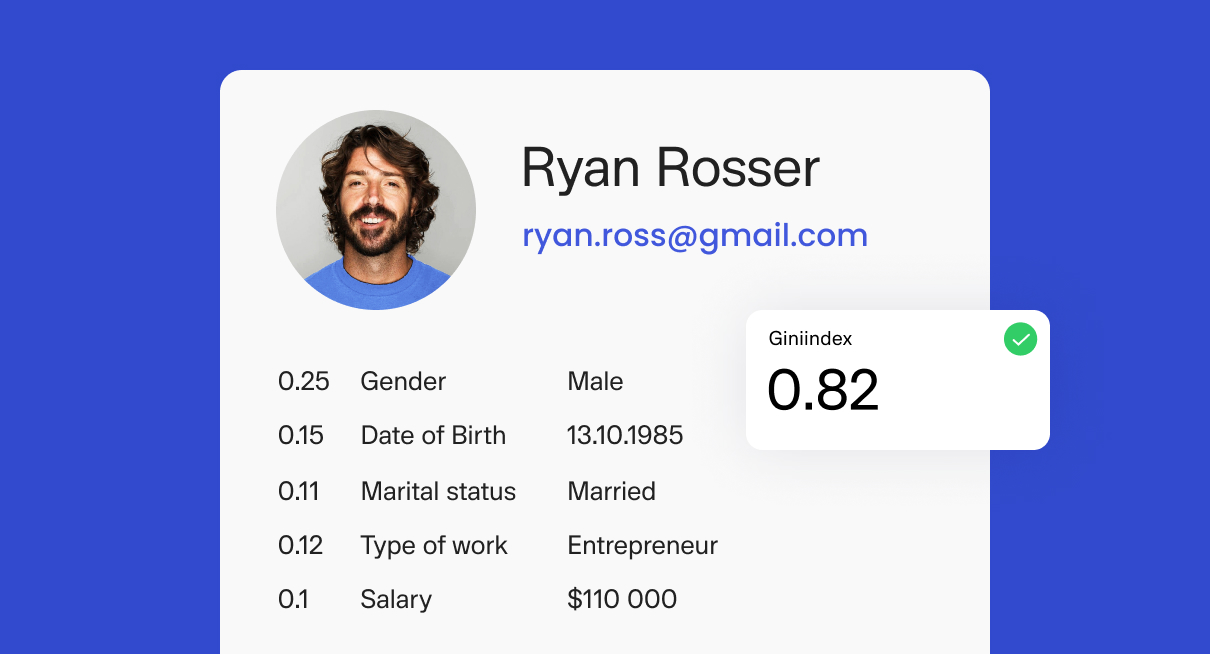
A customer is a business’ best friend. And shouldn’t you know what your best friend likes or dislikes? Yes, but what if that one best friend is actually 100, 1,000 or even 1,000,000 of them? Customer behavior analytics makes knowing your clients, no matter how many there are, simple. Understanding preferences can lead to increases in acquisition rates, stronger engagement, and longer customer retention, giving you an advantage over your competitors.
Customer behavior analytics tracks the way your client interacts with your and other businesses, and their general personality and behavior traits to define their buyer style and what may encourage them to make a purchase.
By monitoring their social media trends, shopping behaviors, patterns of behavior, their background and more, you can extract a lot of valuable data that will help define behavior. But how to get from the raw data to insights, and what’s more, how can you use big data to predict your customers’ behaviors and get results? Let’s find out.
Predictive Customer Analytics in Action
To effectively use predictive customer analytics data, the first thing that you’ll need to do is know precisely why you need it in the first place. Predictive customer analytics is an expansive term covering a wide range of client-related data. Naturally, some of this will be incredibly helpful in predicting future behavior, while other data will just clog up your analysis leaving it difficult to get tangible results. So what are the uses of predictive customer analytics and how can they help you know your customer better?
Predicting demand
Predictive analytics consumer behavior helps plan your business strategy for the near future. Know how many supplies your business may need at any given time to ensure you are always ready for market demand. Plan your stock to save time, money, and energy to focus on more important things. By following your clients shopping patterns, you can predict future behavior and adjust to the demand more efficiently.
Personalizing recommendations
If you work with technology of any kind, you know the world is becoming more personalized than ever. Consumer behavior and analytics tools make it possible to learn more about your clients and personalize recommendations not only for a target group but an individual and allow you to tailor your service to suit them. For example, this may include everything from individual loan rates to personalized in-app recommendations based on past spending.
Scoring more valuable leads
Getting a client in the door (or virtual door) is a fantastic step. However, not every browser is a buyer. So how can you effectively separate your likely buyers from take-a-look-and-go-home browsers? Customer behavior prediction models. These predictive models allow you to analyze potential leads and assess the likelihood they will convert to a sale. Technology such as Gini allows you to focus your energy more on likely buyers, not just browsers.
Distributing content to the right channels
Just because you’re an avid Facebook user doesn’t mean your audience is. In fact, they may be just as likely to be on TikTok or Instagram. Miss the platform of engagement and miss your client. Same goes for web vs. mobile and other distribution channels. But even if you do get the platform right, your content distribution plan needs to be carefully planned and executed. Predictive analytics of consumer behavior help highlight the best platforms to reach your clients and allow you to tailor your strategy more effectively. This drives engagement and allows users to connect with your company.
Targeting ads
Alongside hitting the right channels with your content, it’s important your marketing strategy is on point too. By analyzing your audience, you are more likely to reach your targets than with a more general campaign. Forget about widespread launches, the future is personalized and tailored to your potential buyers. According to one report, 71% of users prefer personalized ads over non-personalised ones, with 25% saying it allows them to discover new products. At the same time, 46% believe it reduces irrelevant advertising, which in turn, optimizes the marketing budget.
Getting high lifetime value stats
Achieving a good ROI is top on any company’s wish list, but how do you know your targets are worth the effort? Predictive analytics to understand the behavior of customers helps predict just how much a potential client is likely to spend when interacting with your business and how often. This is known as lifetime value and can be important for a company seeking to build a long-term relationship with a client rather than a one-time purchase. 76% of companies believe that lifetime value is vital to their business, yet, only 42% of companies are effectively utilising their data to get results. This is crucial as the probablility of selling to a current client is higher (70%) than selling to a new client (20%) and the cost is often lower as well.
Segmenting the market
Even though the fintech lending market is expected to grow at a CAGR of 32.3% between 2021 and 2027, when it comes to connecting with your clients, it’s important to know your market. Customer segmentation is so much more than simple demographics. Market segmentation allows you to go deeper when analyzing your consumers’ data and start to make predictions based on their past market interactions. This will give you a full understanding of your clients and how to connect with them to get results.
How to Use Big Data to Predict your Customers’ Behaviors more Effectively
Now that we know why we need data and the impact it can have on our business, what are some of the steps we can take to realize it and put it into action?
First step: Google Analytics & making predictions with consumer data
Any marketer worth their salt knows Google Analytics (GA), but its capabilities go further than just running a few ad campaigns. Instead, its functionalities allow you to access precious consumer behavior and analytics data to build a deeper connection with your clients and potential clients. Using GA, you can discover:
- Income stemming from online content
- Bounce rates and transactions
- Types of users that connect with your brand
- How likely they are to make a purchase
- Much more.
But how to use GA to get these results? It’s reasonably simple to put into action.
- First connect GA to your site and allow it to gather data.
- Next, it’s time to explore that data. Head to Reports—>Audience—>User Explorer.
- Add the parameters you need, format your dataset and download the info you need.
- Now you can use this data to create the basis for consumer behavior analytics within your company.
Google Analytics is great if you need a comprehensive overview into buyer behavior and interactions with your business. But sometimes, you need to take that further and even consider optimizing the process with smart technologies.
Next step: How to use big data to predict your customers’ behaviors
Turning that data from being just raw numbers and statistics into usable and easy-to-understand insights is the way to go if you want full control over your company’s learning. But to do that you need a little more power. There are a number of technologies that can help you unlock predictive analytics to understand the behavior of customers better.
Such tools are based on smart technology, such as AI (artificial intelligence) or ML (machine learning) that gathers, analyzes, and transforms data to turn it into more intelligible customer learning. Let’s take a look at some of the ways it does this:
Churn prediction
Ever wondered why a customer suddenly stops interacting with your company? You should. This is known as the churn rate and it can come from various sources—web, app, subscription, readership, etc. To understand your business’ churn rates, you’ll need to know more about your clients and what motivates them.
For this you can use big data to predict your customers’ behaviors. Here’s how:
- First, select what you want to learn—for example, the churn rate.
- Next, clean your data and build your customer profiles.
- Now, it’s time to utilize a smart model. In this case, we’re looking for the ‘churn level’. Tools such as Gini can do this easily and let you separate the data to get your churn rate.
Armed with this info, you can act on it to improve your business and, hopefully, reduce the churn rate and increase that all-important customer retention rate.
Cross-selling and upselling
Being able to effectively cross-sell and upsell your products can do wonders for your brand’s profitability. But only when done right. Come across as too ‘pushy’ and you could lose business fast. Instead, choose a smarter path—predictive customer analytics.
Predictive customer analytics highlight opportunities for cross and upselling and allow you to do so with confidence. Here’s how:
- First, analyze and segment your clients, this is your initial dataset.
- Next, create a model—Gini can help with this—that will allow you to effectively dive into the data. Explore the products you’d like to cross or upsell.
- Analyze the market and explore if it’s possible to do so right now. Using smart technologies establish the best possible approach and which clients its intended for.
Now that you know the best approach, you can implement an effective strategy that works to users’ needs and expectations, and results in real profit, not just wasted effort.
Solving problems before they happen
From bugs in your digital service to issues with a feature to just general dissatisfaction, no matter the nature of your business, you will receive a few complaints sooner or later. And while receiving complaints isn’t a big deal—it’s how you know what to improve—the way you deal with them is. 14% of consumers leave a business due to poor complaint handling. Yet, on the flip side, for complaints that are solved swiftly, there’s a purchase intention rate of 82% with a retention rate of 54% on average.
So how can you utilize data to solve problems, even before they happen?
- First, test your digital service—app or web—and find existing issues.
- Next define a strategy to solve them using the data you have.
- Then it’s time to look at consumer behavior data. Track complaints to your customer support team and analyze existing issues. Knowing these issues in advance can help you plan for them.
- Define a strategy for these. For example, solve tech problems, redirect the customer, create a Q&A, design a chatbot, etc. So, when a customer contacts you, you are prepared.
Now that you have a strategy, it’s time to put it into action. Armed with data, you can not only build an effective strategy, but increase customer satisfaction and trust too leading to higher retention rates and more sales overall.
The Future of Customer Behavior Analytics
Analyzing your customer behavior analytics is an excellent way to know your customer better so that you’re able to treat them as your best (professional) friend, not another nameless face. Building satisfaction and trust, you’ll be able to grow your business, retain customers, and ensure profitability.
However, while customer behavior analytics data can answer an almost infinite number of business questions, the most important thing is to effectively engage with the right technology to get the results you desire the first time around. To do this, it’s important that you have the correct software solutions engaged at the right time, so you don’t get lost in a sea of data.
Wanna try GiniMachine for customer behavior prediction? Get in touch to book a demo.



